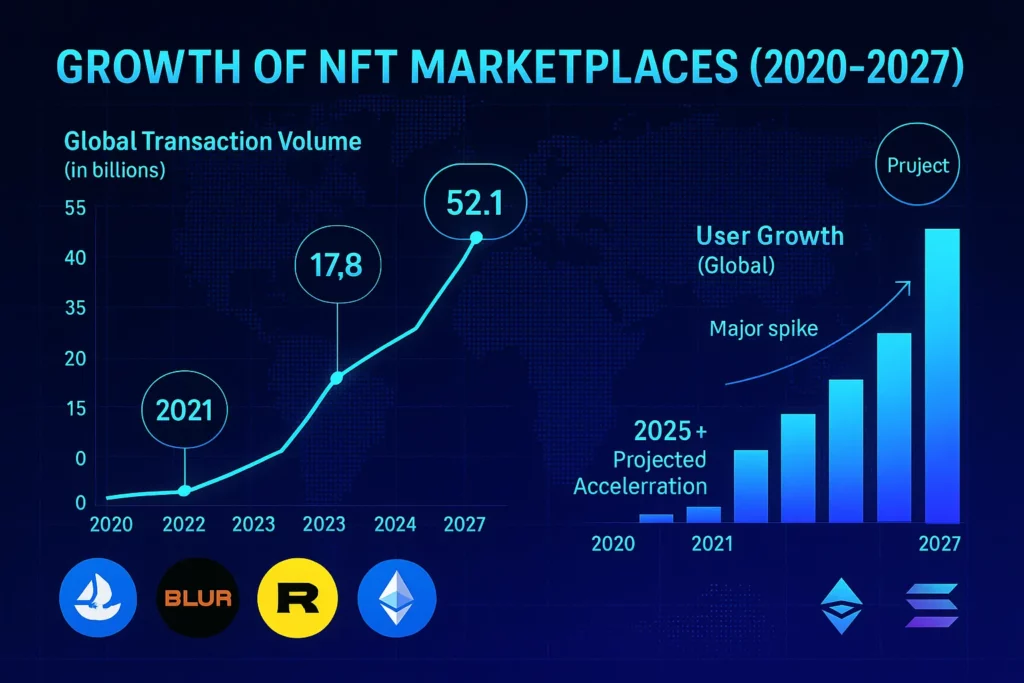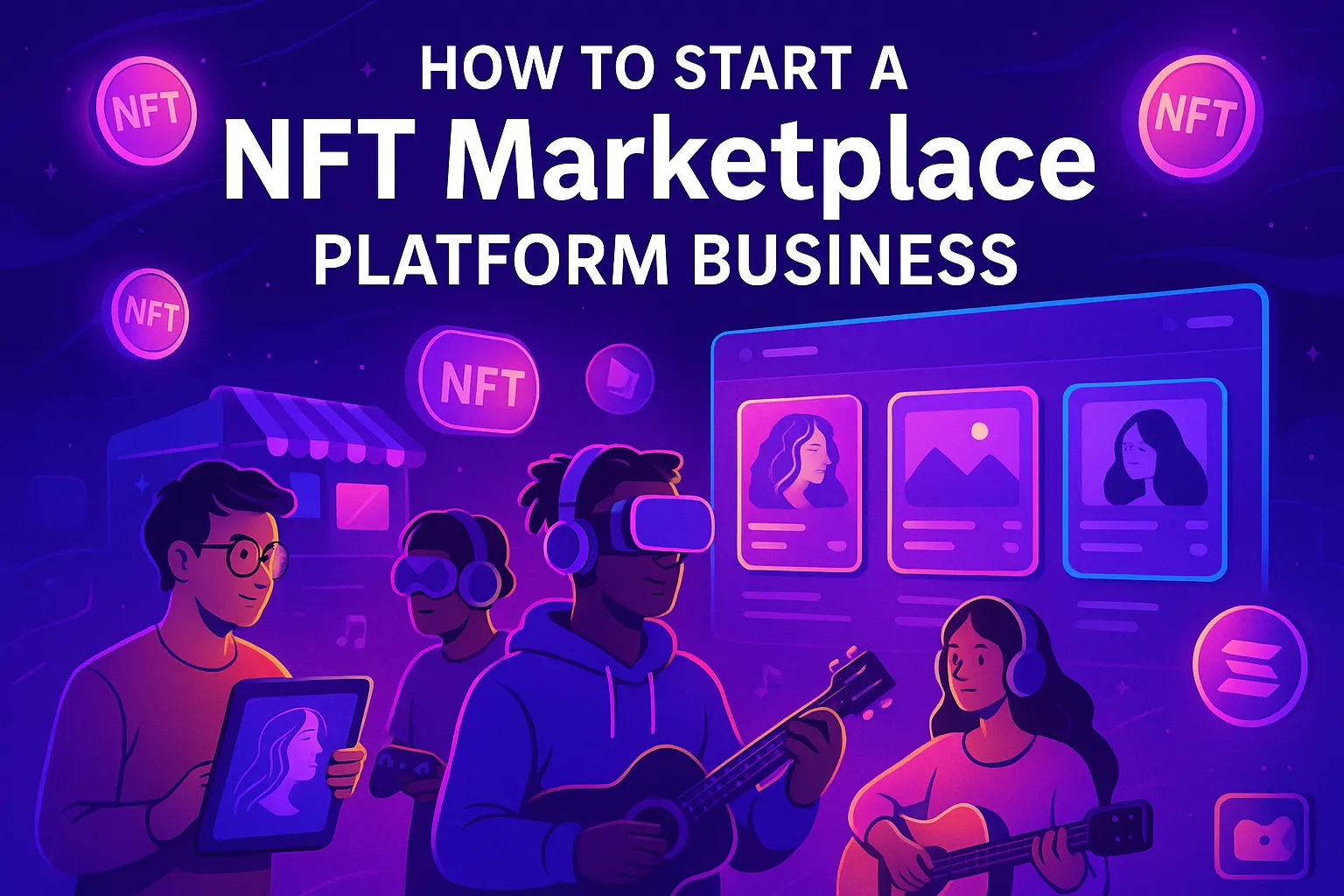If you’re the kind of person who screenshots cool digital art, dreams of owning a CryptoPunk, or thinks, “I wish I’d built OpenSea before OpenSea,” — you’re in the right place. NFTs (non-fungible tokens) are more than a buzzword now. They’re a full-blown movement, blending digital ownership, creator empowerment, and tech swagger into one crazy ride.
But while everyone’s hyped about buying and flipping NFTs, the real game-changers are the ones building the marketplaces. Platforms like Blur, SuperRare, and OpenSea are raking in millions — not from NFTs themselves, but by becoming the go-to hubs where others trade them. That’s the power of owning the rails, not just the train.
So if you’re an entrepreneur with an eye for crypto trends or a startup team itching to launch the next Web3 unicorn, starting your own NFT marketplace might just be your golden ticket. In this blog, we’ll walk you through the what, why, and how — and yes, Miracuves can help you build your clone app that’s fast, secure, and future-ready.
Why NFT Marketplaces Are a Hot Business
NFT marketplaces are like the Amazons of Web3. Instead of selling physical goods, they facilitate digital ownership. But here’s the kicker — they charge transaction fees, take commissions, and often provide premium features for creators and collectors alike. It’s a low-inventory, high-margin model if done right.
According to Statista, the global NFT market is projected to reach $3.2 billion by 2027, and marketplaces play a central role in this value chain. The opportunity? You don’t need to reinvent blockchain — just create a better, more tailored platform for specific communities, artists, or even memes.

Key Features Your NFT Platform Must Have
Before you jump into code or hire developers, let’s look at what makes NFT platforms tick.
User Authentication & Wallet Integration
Most users come in with Metamask or WalletConnect. Your platform needs secure, seamless login experiences tied to crypto wallets — think Web3 sign-in, not email/password.
NFT Minting & Listings
Allow users to mint (create) their NFTs and list them with metadata, pricing, royalties, etc. Think of it like Shopify for digital goods.
Bidding, Fixed Price & Auctions
Let buyers choose how they want to acquire — instant purchase, timed auctions, or bid wars. More engagement = more money for you.
Creator Royalties
This is the heart of NFT marketplaces — ensure artists get a % every time their work is resold. It’s a blockchain-powered loyalty program.
Smart Contract Infrastructure
Under the hood, smart contracts do all the heavy lifting. These should be secure, gas-efficient, and preferably open-source for transparency.
The Giants of the Game — Top NFT Marketplaces (and What You Can Learn From Them)
OpenSea
The OG of NFT marketplaces. Supports Ethereum, Polygon, Solana, and more. It focuses on scale, simplicity, and community.
→ What to learn: Go cross-chain early. Offer mobile support and explore gamified rewards.
Blur
The new kid disrupting the whales. Built for pro-traders with real-time data, analytics, and zero marketplace fees.
→ What to learn: Build for power users. Data dashboards and low-latency interactions matter.
SuperRare
Curated, artist-first, and high-end. Think of it as the Sotheby’s of NFTs.
→ What to learn: Curation = value. Sometimes, less noise and more exclusivity wins.
Rarible
Open, community-driven, and multi-chain. They’ve even got a native token ($RARI) for governance.
→ What to learn: Tokenomics can drive retention. Consider DAO-style governance.
Foundation
Focused on high-quality visuals and artist empowerment. Think Tumblr-meets-Web3.
→ What to learn: UX/UI matters. Make your platform feel like a digital gallery, not a stock exchange.
Monetization Models That Actually Work
You’re not just building a cool project. You’re building a business. Here’s how NFT marketplaces rake in revenue:
Transaction Fees
Take a cut (usually 2–5%) of every sale. Most platforms go here first.
Listing Fees
Charge creators a small amount to list — especially useful for curated marketplaces.
Premium Features
Offer paid analytics, priority placement, or pro dashboards for serious collectors.
Token Launch
Launch your own utility or governance token. It drives community and platform value — but be ready to commit to tokenomics.
Steps to Launch Your NFT Marketplace Platform
Let’s simplify the madness. Here’s your blueprint:
- Niche Down: Decide your target audience — artists, gamers, music creators, etc.
- Choose Blockchain(s): Ethereum? Solana? Polygon? Or multi-chain?
- Build the MVP: Focus on core features — wallet login, minting, listing, purchasing.
- Design with UX in Mind: NFT trading can be confusing. Your UI shouldn’t be.
- Test & Deploy Smart Contracts: Secure, tested contracts save you from costly bugs.
- Market It Smartly: Leverage Discord, Twitter/X, and influencer drops.
- Scale & Expand: Add advanced analytics, API integrations, mobile support.
Why Go With a Clone App Model?
You don’t need to start from scratch. Clone apps — modeled on successful platforms like OpenSea or Blur — can save you months of dev time and thousands in budget. They’re customizable, scalable, and proven to work.
Conclusion
The world of NFT marketplaces isn’t just a playground for pixelated apes or quirky collectibles — it’s the foundation of a new digital economy. One where artists, brands, gamers, and visionaries can own, trade, and profit from their creativity in ways never seen before.
And guess what? The door’s still wide open. If you’re bold enough to launch your own platform, you’re not late — you’re early to the real party.
We empowers builders like you to roll out top-tier NFT marketplace clones that are built for speed, scale, and success. So, ready to claim your piece of the future? Let’s build it — together.
FAQs
Q1. What is an NFT marketplace platform?
It’s a digital platform that allows users to buy, sell, and mint non-fungible tokens (NFTs), usually using blockchain tech like Ethereum.
Q2. How do NFT platforms make money?
Mostly through transaction fees, listing charges, premium features, and sometimes tokenomics (native platform tokens).
Q3. Can I launch an NFT platform without coding?
Technically yes, using white-label or clone solutions. But customization and scalability will eventually need developers.
Q4. Which blockchain is best for NFT marketplaces?
Ethereum is the most popular, but Solana, Polygon, and Flow are gaining traction due to lower gas fees.
Q5. Is it legal to run an NFT marketplace?
In most countries, yes — but always check local regulations on crypto, securities, and digital assets.
Q6. How much does it cost to build an NFT marketplace?
Using a ready-made solution from Miracuves, you can build a full-featured NFT marketplace for $2K–$5K. The platform is ready for deployment within 3–6 days, saving both time and development cost.








